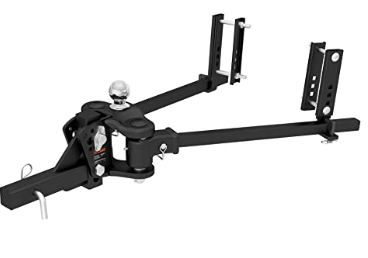What is a Weight Distributing Hitch?

One of the most important pieces of equipment is a weight distributing hitch. A weight distributing hitch is simply a piece of hardware that allows for the even distribution of weight between your trailer and tow vehicle. This can help to improve stability and reduce sway, making towing safer and more comfortable.
Why Do You Need a Weight Distributing Hitch?
When you tow a trailer, the weight of the trailer is transferred to the tow vehicle. This can cause the tow vehicle to squat, which can make it difficult to control. A weight distributing hitch helps to distribute the weight of the trailer evenly, which can help to prevent the tow vehicle from squatting.
A weight distributing hitch can also help to reduce sway. Sway is when the trailer starts to move from side to side. This can be caused by a variety of factors, including wind, uneven road surfaces, and braking. A weight distributing hitch can help to reduce sway by stabilizing the trailer.
How to Choose the Right Weight Distributing Hitch
There are a few different types of weight distributing hitches available, so it's important to choose the right one for your needs. The type of hitch you need will depend on the weight of your trailer and the type of tow vehicle you have.
If you have a small trailer, you may be able to get away with using a basic weight distributing hitch. However, if you have a large trailer or a heavy tow vehicle, you'll need a more heavy-duty hitch.
It's also important to consider the features of the hitch when you're making your decision. Some hitches have features like sway control and anti-sway bars. These features can help to further improve stability and reduce sway.
How to Install a Weight Distributing Hitch
Once you've chosen the right weight distributing hitch, it's important to install it properly. The installation process will vary depending on the type of hitch you have. However, most hitches can be installed in a few hours with basic tools.
here is a step-by-step guide for installing a weight distributing hitch:
- Measure your trailer and vehicle height
Your vehicle and trailer should be parked on a level surface and then simply measure the height of the trailer's coupler from the ground. Then, measure the height of your tow vehicle's receiver from the ground.
- Install the shank
The shank is the part of the hitch that attaches to the tow vehicle's receiver. It is important to choose the correct shank for your tow vehicle. The shank should be the same height as the receiver on your tow vehicle.
To install the shank, insert it into the receiver and tighten the bolts.
- Install the head
The head is the part of the hitch that attaches to the trailer's coupler. It is important to choose the correct head for your trailer. The head should be the same height as the coupler on your trailer.
To install the head, slide it over the shank and tighten the bolts.
- Install the adjustment rod
The adjustment rod is used to adjust the height of the hitch. It is important to adjust the rod so that the hitch is level with the ground.
To install the adjustment rod, insert it into the hole in the head and tighten the bolt.
- Install the spring bars
The spring bars are used to absorb the weight of the trailer. They are important for reducing sway and improving stability.
To install the spring bars, attach them to the head and tighten the bolts.
- Couple the trailer to your vehicle
Once the hitch is installed, you can couple the trailer to your vehicle. To do this, lower the trailer's coupler onto the ball of the hitch and tighten the coupler lock.
- Re-measure your vehicle height
Once the trailer is coupled to your vehicle, re-measure the height of your vehicle from the ground. The vehicle should be no more than 1 inch higher than it was before you installed the hitch.
If the vehicle is more than 1 inch higher, you may need to adjust the height of the hitch.
Here are some additional tips for installing a weight distributing hitch:
- Make sure the hitch is properly aligned with the trailer's coupler.
- Use a torque wrench to tighten all of the bolts.
- Read the instructions that come with the hitch carefully.
- If you are not comfortable installing the hitch yourself, take it to a qualified mechanic.
Subscribe
Stay updated with our newsletter
The Benefits of Using a Weight Distributing Hitch
There are a number of benefits to using a weight distributing hitch. These benefits include:
- Improved stability
- Reduced sway
- Easier towing
- Increased safety
Where to Buy a Weight Distributing Hitch
Weight distributing hitches are available at most auto parts stores and online retailers. When you're buying a hitch, it's important to buy from a reputable dealer. This will ensure that you get a quality hitch that will last.
Images provided by: depositphotos.com
Conclusion
A weight distributing hitch is an important safety investment for anyone who plans on towing a trailer. By distributing the weight of your trailer evenly, a weight distributing hitch can help to improve stability and reduce sway, making towing safer and more comfortable.

